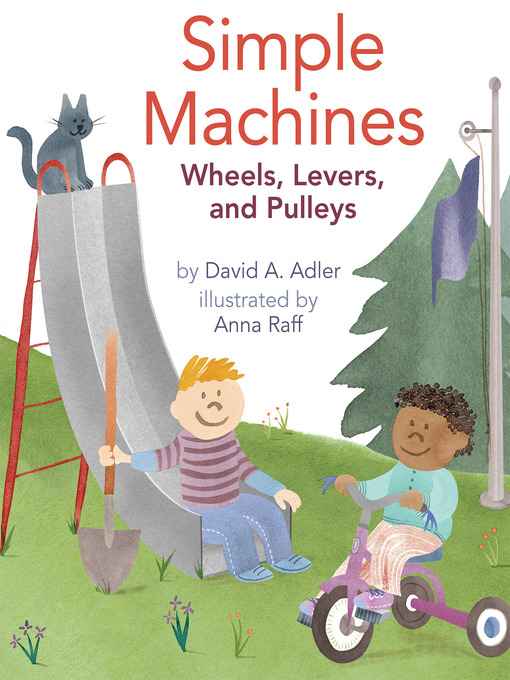Machines make work easier— helping break things apart, lift heavy objects, and change the power and direction of force applied to them. In this accessible picture book, celebrated nonfiction author David A. Adler outlines different types of simple machines—wedges, wheels, levers, pulleys, and more—and gives common examples of how we use them every day.
Anna Raff's bright illustrations show how simple machines work—and add a dose of fun and humor, too. Two appealing kids and their comical cat use machines to ride see-saws, turn knobs, and even eat apples.
Perfect for classrooms or for budding engineers to read on their own, Simple Machines uses clear, simple language to introduce important mechanical vocabulary, and easy-to-understand examples to illustrate how we use machines to solve all kinds of problems.
Don't miss David A. Adler and Anna Raff's other science collaborations—including Light Waves; Magnets Push, Magnets Pull; and Things That Float and Things That Don't.
-
Creators
-
Publisher
-
Release date
January 23, 2015 -
Formats
-
Kindle Book
-
OverDrive Read
- ISBN: 9780823433513
-
-
Languages
- English
-
Levels
- ATOS Level: 4
- Lexile® Measure: 580
- Interest Level: K-3(LG)
- Text Difficulty: 2-3
-
Reviews
-
School Library Journal
March 1, 2015
K-Gr 3-While Adler and Raff's Things That Float and Things That Don't (Holiday House, 2013) succeeded in introducing STEM principles, their latest picture book offers more confusion than clarification in its attempts to cover a variety of simple machines in a single title. The soothing, sumi ink-washed illustrations follow two children, a cat, and a lumberjack as they explore wedges, inclined planes, levers, wheels and axles, and pulleys. The screw is mentioned merely as a sidebar of inclined planes. The book lacks visual cues and headings, and readers may be caught unawares jumping from one machine to the next, especially as illustrations build upon one another. Vocabulary words are in bold, but most are never clearly defined, and the concluding sentence leaves readers hanging on a pulley: "With the pulleys, the motor in the crane needs less lifting power." Libraries will be better served by Bellwether's "Simple Machines," which covers one simple machine per title. VERDICT An attractive yet unsuccessful attempt; give this one a miss.-Jennifer Wolf, Beaverton City Library, OR
Copyright 2015 School Library Journal, LLC Used with permission.
-
Kirkus
March 1, 2015
Continuing to branch out into science concepts (Things That Float and Things That Don't, 2013), the math and biography whiz tackles the elementary topic of simple machines. Using sumi ink washes that have been digitally colored and arranged, Raff's illustrations loosely follow three characters as they use simple machines: a Caucasian lumberjack dad (in faded red flannel), his blond son, and his playmate, an African-American boy with curly hair. Moving from wedge to inclined plane to lever to wheel and axle and finally to pulley, Adler presents the simple machines one by one, describing their parts and how they make work easier. He takes care to provide many examples that are sure to be familiar to readers: teeth (natural wedges!), playground equipment, a Ferris wheel, a screw, a flagpole. In addition to the machines, Adler explains friction. Terms in boldface stand out from the rest of the text, but there is no glossary or any backmatter at all to summarize or review the information presented; the absence is felt, especially since the book seems to just stop-there's no closure. Still, this is as solid a look at simple machines as any that exists outside of dry textbooks, and at least readers can imagine a narrative for the two young boys. (Informational picture book. 4-8) -
Booklist
April 15, 2015
Grades K-2 What do a slide, a flagpole, and a tricycle have in common? They illustrate principles of physics relating to simple machines: an inclined plane, a pulley, a wheel and axle, a wedge and a lever. The emphasis in each description is that simple machines make work easier. An inclined plane can be a simple ramp, a winding road leading to the mountain top, or a screw. The wheel and axle of a tricycle is shown next to the more complex Ferris wheel. Children will be drawn to the depictions of the machines in familiar situations such as turning on a water faucet or playing on a seesaw. The charming illustrations, featuring children, adults, and even a cat, enhance the impact of the message by depicting a small community going about their lives and using simple machines to make work easier.(Reprinted with permission of Booklist, copyright 2015, American Library Association.) -
The Horn Book
July 1, 2015
"A gear is a wheel with teeth. Gears can change the speed, power, and direction of a machine's work." With the help of a seen-but-not-heard cat and a collection of children, this book gives accessible examples of the simple machines of the title, such as seesaws, faucets, and construction cranes. Pastel illustrations are lively and friendly, with just enough detail.(Copyright 2015 by The Horn Book, Incorporated, Boston. All rights reserved.)
-
subjects
Languages
- English
Levels
- ATOS Level:4
- Lexile® Measure:580
- Interest Level:K-3(LG)
- Text Difficulty:2-3
Loading
Why is availability limited?
×Availability can change throughout the month based on the library's budget. You can still place a hold on the title, and your hold will be automatically filled as soon as the title is available again.
The Kindle Book format for this title is not supported on:
×- - Kindle 1
- - Kindle 2
- - Kindle DX
- - Kindle Keyboard
- - Kindle 4
- - Kindle Touch
- - Kindle 5
- - Kindle Paperwhite
- - Kindle 7
- - Kindle Voyage
Read-along ebook
×The OverDrive Read format of this ebook has professional narration that plays while you read in your browser. Learn more here.




